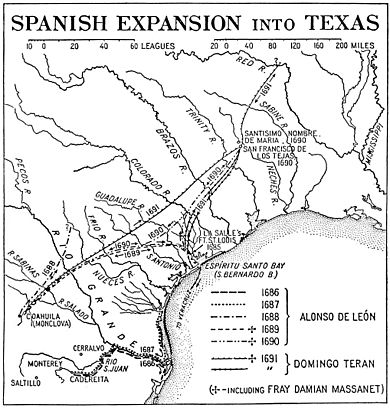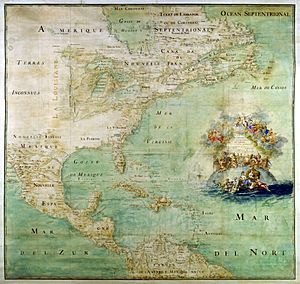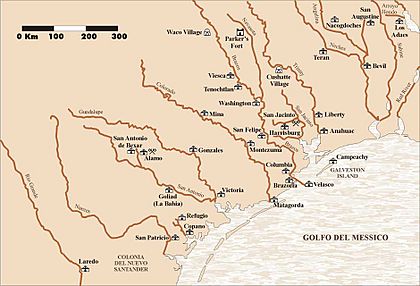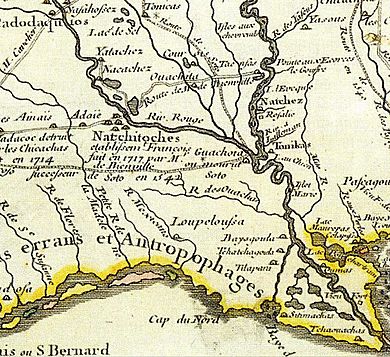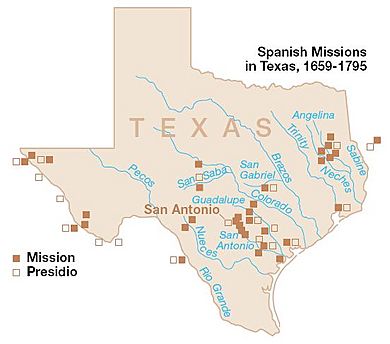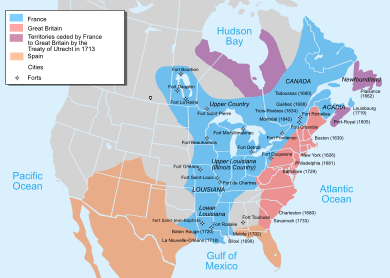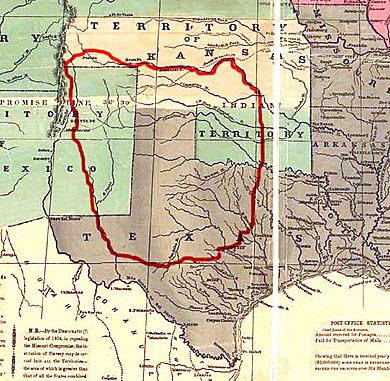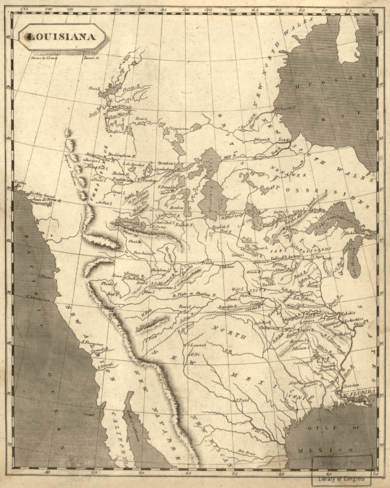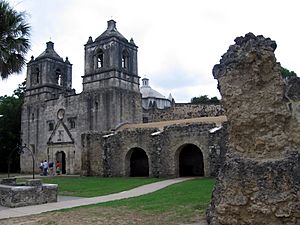Spanish Texas facts for kids
Spanish Texas was a part of the Viceroyalty of New Spain. This was a huge area controlled by Spain in North America from 1690 to 1821. Texas was one of the "interior provinces," meaning it was far from the main Spanish government.
Spain first claimed this land in 1519. It included parts of what is now Texas. But Spain did not try to settle here until 1689. That's when they found out about a failed French colony called Fort Saint Louis.
In 1690, Alonso de León led Catholic missionaries into east Texas. They built the first mission there. But local tribes did not want the Spanish on their land. So, the missionaries went back to Mexico. Texas was left alone for about 20 years.
The Spanish returned to Texas in 1716. They built more missions and a presidio (a fort). This was to keep French settlers from French Louisiana away from Spanish lands. In 1718, the first town in Texas, San Antonio, was founded. It was a stop for people traveling between missions. Soon, Lipan Apache tribes started raiding the new town.
These raids continued for almost 30 years. In 1749, Spanish settlers and the Lipan Apache made peace. But this made other tribes, like the Comanche, Tonkawa, and Hasinai, angry. They started attacking Spanish settlements instead. People were afraid of these attacks. Texas was also far from other Spanish areas. This made it hard to get new settlers to move there. Texas remained one of the least populated provinces. Attacks finally slowed down in 1785. That's when Spain and the Comanche made a peace agreement. The Comanche then helped fight the Lipan Apache and Karankawa tribes. More missions were built, helping other tribes become Christian peacefully.
In 1762, France gave French Louisiana to Spain. This meant Texas was no longer a "buffer" province between Spanish and French lands. The Spanish closed the easternmost Texas settlements. People moved to San Antonio. However, in 1799, Spain gave Louisiana back to France. In 1803, Napoleon Bonaparte sold Louisiana to the United States. This was called the Louisiana Purchase. U.S. President Thomas Jefferson said this purchase included all land east of the Rocky Mountains and north of the Rio Grande. This included a large part of Texas. The exact border was unclear until 1819. In the Adams–Onís Treaty, Spain gave Spanish Florida to the United States. In return, the U.S. agreed that the Sabine River was the eastern border of Spanish Texas.
From 1810 to 1821, Texas faced a lot of trouble during the Mexican War of Independence. Rebels overthrew the Spanish Governor Manuel María de Salcedo in 1810. But he escaped and organized a counter-attack. Three years later, the Republican Army of the North took over the Spanish government in Texas. They executed Salcedo. Spain fought back very harshly. By 1820, fewer than 2,000 Spanish citizens lived in Texas. In 1821, Spain lost control of New Spain. Texas became part of the state of Coahuila y Tejas within the new country of Mexico. This time in Texas history is known as Mexican Texas (1821-1836).
Spain left a big mark on Texas. Their livestock caused mesquite plants to spread. Farmers used new ways to grow crops and irrigate land. This changed the landscape forever. Many rivers, towns, and counties in Texas still have Spanish names. Spanish building styles are also still popular. Texas later used many American laws. But some Spanish legal practices survived. These include rules about protecting your home from debt and sharing property between spouses.
Contents
Where was Spanish Texas?
Spanish Texas (called Tejas) was a province in the northeastern part of Viceroyalty of New Spain. To the south, Tejas bordered the provinces of Coahuila and Nuevo Santander. The border between these areas was the Medina River and the Nueces River. This was about 100 miles (161 km) northeast of the Rio Grande. To the east, Texas bordered French Louisiana. Spain said the Red River was the border. But France claimed the Sabine River, which was 45 miles (72 km) to the west.
First Attempts to Settle Texas
Alonso Álvarez de Pineda claimed Texas for Spain in 1519. But Spain mostly ignored the area until the late 1600s. In 1685, Spain learned that France had started a colony between New Spain and Florida. Spain's King Carlos II thought this French colony was a threat. He wanted to remove this "thorn" from America.
Spain did not know where the French colony was. So, they sent ten expeditions over three years. They did not find the French settlement. But they learned a lot about the Gulf Coast region. In 1689, the last expedition found a French deserter living with the Coahuiltecans. In April 1689, this Frenchman helped Alonso de León guide the Spanish to Fort Saint Louis. The Karankawa Indians had already destroyed the fort. De León's group also met the Caddo people. The Caddo lived between the Trinity and Red Rivers. They seemed interested in learning about Christianity.
De León sent a report to Mexico City. It made the Spanish government very hopeful. They believed God had helped destroy the French fort. De León suggested building forts along the Rio Grande, Frio River, and Guadalupe River. He also wanted missions among the Hasinai Indians in East Texas. The Spanish called these Indians the Tejas. This word was often written as Texas, which became the name of the future province.
Missions in Texas
The Viceroy (the ruler of New Spain) agreed to build a mission. But he said no to the forts. Spain did not have enough money. On March 26, 1690, Alonso de León left with 110 soldiers and missionaries. They first burned Fort Saint Louis to the ground. Then they went to East Texas. Mission San Francisco de los Tejas was finished in May. Its first mass was on June 1. The missionaries did not want the soldiers nearby. When de León went back to Mexico, only 3 soldiers stayed. Father Damián Massanet, the main priest, left to meet other tribes. He then returned to Mexico to ask for more priests.
On January 23, 1691, Spain named Domingo Terán de los Ríos the first governor of Texas. Terán was told to help build seven new missions. He could only find 10 friars and 3 lay brothers. His group reached the existing mission in August 1691. They found that priests had built a second mission, Santísimo Nombre de María. It was 5 miles (8 km) east of San Francisco de los Tejas. One priest had died, leaving only two. The Indians often stole their animals and were becoming rude. Terán did not build more missions because supplies were low. When he left Texas, most missionaries went with him. Only 3 religious people and 9 soldiers stayed.
A smallpox disease also hit the area. The Indians had no protection from it. They first blamed the disease on the baptismal water. After many died, the survivors fought against the missions. In 1693, the Caddo told the Franciscan missionaries to leave or be killed. The missionaries buried the church bells and burned the mission. Then they went back to Mexico. This first attempt to settle Texas failed. But Spain learned more about Texas land and rivers. They realized that even friendly Indians needed to be forced to convert. For the next 20 years, Spain ignored Texas again.
Spain and France in Texas
In the early 1700s, France again made Spain interested in Texas. In 1699, French forts were built at Biloxi Bay and on the Mississippi River. This ended Spain's full control of the Gulf Coast. Spain did not like France being in Louisiana. But they did not do much to stop them. The two countries became allies during a war in Europe. But Spain still did not want the French to trade in their land. In 1707, Spain heard rumors of French people in Texas. The viceroy ordered governors to stop foreigners and their goods. Soldiers went into Texas to stop the Tejas Indians from trading with the French. But they turned back after learning the Tejas chief was still unhappy with Spain. The soldiers did visit the San Antonio River area. They were impressed with the land and water. They named the river San Antonio de Padua.
In 1711, a Franciscan missionary named Francisco Hidalgo wanted to restart missions with the Caddos. Spain would not give him money or soldiers. So Hidalgo asked the French governor of Louisiana, Antoine de la Mothe Cadillac, for help. Cadillac wanted Louisiana to make money. He thought Spanish settlers nearby could create new trade. He sent Louis Juchereau de St. Denis to find Hidalgo. In July 1714, the French group reached the Spanish border. Hidalgo was there. St. Denis was arrested but later released. Spain realized France could threaten other Spanish areas. So they ordered Texas to be settled again. It would be a buffer between French Louisiana and New Spain.
On April 12, 1716, an expedition led by Domingo Ramón left for Texas. They planned to build four missions and a fort with 25 soldiers. The group had 75 people, including 3 children and 7 women. These were the first recorded female settlers in Spanish Texas. St. Denis also joined the Spanish group after marrying a Spanish woman.
The group reached the Hasinai people's land in June 1716. They were welcomed. On July 3, Mission San Francisco was reopened as Mission Nuestro Padre San Francisco de los Tejas. It was for the Neche Indians. A few days later, Mission Nuestra Señora de la Purísima Concepción was built. It was at the main village of the Hainai. A third mission, Nuestra Señora de Guadalupe, was built 15 miles (24 km) east. A final mission, San José de los Nazonis, was built for the Nazoni Indians. A fort, Nuestra Señora de los Dolores, was built across from San Francisco de los Tejas.
During this time, the area was called the New Philippines. Missionaries hoped for royal support. This name was official for decades but later changed back to 'Texas'.
At the same time, the French built a fort in Natchitoches. The Spanish responded by building two more missions west of Natchitoches. These were San Miguel de los Adaes and Dolores de los Ais. These missions were in a disputed area. France said the Sabine River was the border. Spain said the Red River was the border. This left a 45-mile (72 km) overlap.
The new missions were over 400 miles (644 km) from the nearest Spanish settlement. It was hard to get supplies. By 1718, the missionaries were in trouble. Martín de Alarcón, the new governor of Texas, wanted a stopover point. This would be between the settlements along the Rio Grande and the new East Texas missions. The Coahuiltecans had a good community near the San Antonio River. Alarcón led 72 people, including 10 families, into Texas on April 9, 1718. They brought many animals. On May 1, they built a temporary mission, San Antonio de Valero. Its chapel later became known as the Alamo. Alarcón also built a fort, San Antonio de Béxar, 1 mile (1.6 km) north of the mission. He also started the town of Béjar, now San Antonio. It was the only villa (town) in Texas. Settlers farmed and raised animals. Alarcón then went to the East Texas missions. He found a lot of illegal trade with France.
The next year, the War of the Quadruple Alliance started. Spain fought against France and other countries. In June 1719, 7 Frenchmen from Natchitoches took control of Mission San Miguel de los Adaes. The Spanish colonists and soldiers fled to San Antonio.
Marquis of San Miguel de Aguayo volunteered to take Texas back. He raised an army of 500 soldiers. Aguayo became governor of Coahuila and Texas. This delayed his trip until late 1720. Just before he left, the fighting in Europe stopped. The King of Spain told them not to invade Louisiana. Instead, they should retake Eastern Texas peacefully. The expedition brought over 2,800 horses and 6,400 sheep. This was the first large "cattle" drive in Texas. It greatly increased the number of farm animals in Texas. This marked the start of Spanish ranching.
In July 1721, Aguayo's group met St. Denis near the Neches River. St. Denis had returned to the French. He was leading a raid on San Antonio. St. Denis realized he was outnumbered. He agreed to leave East Texas and go back to Louisiana. Aguayo then ordered a new Spanish fort built. It was called Nuestra Señora del Pilar de los Adaes. It was near present-day Robeline, Louisiana, only 12 miles (19 km) from Natchitoches. This new fort became the first capital of Texas. It had 6 cannons and 100 soldiers. The six East Texas missions were reopened. Presidio Dolores was moved near mission Purísima Concepción. The Spanish then built another fort, Presidio La Bahía del Espíritu Santo, where the French Fort St. Louis had been. They also built a mission nearby, Espíritu Santo de Zúñiga, for the Coco, Karankawa, and Cujane Indians. Aguayo returned to Mexico City in 1722. When he started, Texas had only San Antonio and about 60 soldiers. When he left, Texas had 4 forts, over 250 soldiers, 10 missions, and the town of San Antonio.
Challenges in Settling Texas
After Aguayo left, the new viceroy of New Spain wanted to cut defense costs. He sent Colonel Pedro de Rivera y Villalón to inspect the northern border. Rivera inspected the area from California to East Texas. He reached San Antonio in August 1727. He liked the forts at Los Adaes, Presidio Nuestra Señora de Loreto, and San Antonio. But he did not like Presidio de los Tejas. Its 25 soldiers were guarding empty missions. The native people did not want to live near the missions. They refused baptism unless they were dying. The Indians had weapons, so the Franciscans could not force them. The frustrated missionaries asked for 50 soldiers to burn Indian homes and force them to move. But no troops came.
Rivera suggested closing Presidio de los Tejas. He also wanted to reduce soldiers at other forts. His ideas were approved in 1729. 125 troops were removed from Texas. Only 144 soldiers remained, divided among Los Adaes, La Bahía, and San Antonio. The three East Texas missions that depended on Presidio de los Tejas moved to the San Antonio River in May 1731. This made five missions in the San Antonio area. These missions usually had fewer than 300 Indians. Many of them had nowhere else to go.
Spain did not want its colonies to make their own goods. Trade was limited to Spanish goods carried on Spanish ships. Most ports, including those in Texas, were closed to trade. This was to stop smugglers. Goods for Texas had to go to Veracruz. Then they were carried over mountains to Mexico City. Finally, they were sent to Texas. This made goods very expensive. Settlers often had to buy supplies from the French. The French fort at Natchitoches had many goods. Without much to trade, Spanish missionaries and settlers had little to offer the Indians. The Indians stayed loyal to French traders.
Apache Attacks
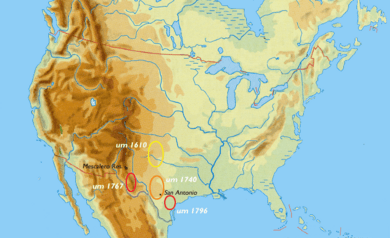
Tribes traded freely. Many soon had French guns. Others had Spanish horses. Tribes without these were at a disadvantage. The Lipan Apache were farmers. But they were pushed by the Comanche, who had horses. They were also pushed by the Wichita, who had guns. The Apaches hated the Tejas of East Texas. They also hated the Spanish because they were friends with the Tejas. After finding San Antonio in 1720, the Apache often raided the area. They stole animals, especially horses. About 3 Spaniards died each year from Apache attacks. About 100 animals were stolen each year. Spain fought back, capturing animals and Apache people. The Apache captives were used as servants. By 1731, the San Antonio fort asked the government for help to make peace.
The Spanish government thought settlers would defend their land. This would reduce the need for forts. But Texas was not appealing to most settlers. There were armed tribes, high costs, and no precious metals. In 1731, Spain moved 55 people from the Canary Islands to San Antonio. Most were women and children. At that time, only 300 Spanish settlers lived in San Antonio. Another 200 were spread out in the colony. The new immigrants started farming. They renamed the town San Fernando de Béxar. This was the first civilian government in Texas. Juan Leal Goraz, the oldest settler, became the first councilman.
The Islanders were given special titles. The older settlers did not like this. The newcomers did not know how to handle horses. This made them useless against the Apaches. The Islanders were mostly farmers. They refused to build fences. This caused problems when animals trampled their fields. By the 1740s, people started marrying each other. This helped reduce the fighting. The original settlers were allowed to be leaders too.
Apache raids made San Antonio uneasy. Some families left. Others stayed in town for safety. The worst attack was on June 30, 1745. 350 Apache raided San Antonio at night. This was revenge for a Spanish military campaign. 100 Indians from Mission Valero helped fight them off. The Apache also attacked other tribes, like the Deadose and Tonkawa. In the 1740s, these weaker tribes asked for missions. They hoped Spain would protect them. Mission San Francisco Xavier was built in January 1746. It was for the Deadose, Mayeye, and Coco Indians. In 1748, the Apaches raided the mission four times. They killed three soldiers and four Indians. Many Indians left the mission because of the attacks. But missionaries built two more missions, San Ildefonso and Nuestra Señora de la Candelaria, the next year. Within six months, all potential converts at San Ildefonso left. By 1755, the missions moved to the San Marcos River.
Missions for the Apache
Peace was made in August 1749. Apache chiefs and Spanish officials buried weapons in San Antonio. This was a symbol of peace. Spain also promised to help the Apache militarily. The Lipan Apache had asked for missions many times. In 1757, all property from the San Gabriel missions moved. The fort that protected them also moved. They went to the new Mission Santa Cruz de San Sabá. This was northwest of San Antonio. A wooden fort was built 3 miles (4.8 km) from the mission. It was on the other side of the river. This was so soldiers would not corrupt the Indians. The fort could hold 400 people, including 237 women and children.
Apaches avoided the mission. On March 16, 1758, a group of Comanche, Tonkawa, and Hasinai tribes attacked. They were angry that Spain was helping their enemies. They burned the mission and killed eight people. San Sabá was the only Spanish mission in Texas completely destroyed by Indians. It was never rebuilt. The Indian force had 2,000 members. But they did not attack the fort.
Spain did not want to abandon the area. They feared it would make them look weak. While they planned a response, Indians stole all the horses from San Saba. They killed 20 soldiers. In October 1759, Spain sent Colonel Diego Ortiz Parrilla north. He went to the Red River to get revenge. The tribes knew he was coming. They led Parrilla's army to a fortified Wichita village. It had a fence and a moat. Natives had French guns and waved a French flag. After a fight, 52 Spaniards were killed or wounded. The Spanish retreated. The San Sabá fort was replaced with a stone fortress. But the Comanches stayed close. They killed any soldiers who left the fort. By 1769, Spain abandoned the fort.
In 1762, missionaries built two unauthorized missions south of San Sabá. They were in the Nueces River valley. For several years, the Apache lived in the missions most of the year. They left in winter to hunt buffalo. One mission closed in 1763 when the Apache did not return. The other mission closed in January 1766. A force of 400 northern natives attacked. They killed 6 Apaches and took 25 captives. They also took all the animals. 41 Spanish troops ambushed the northern tribes. Over 200 Indians and 12 Spanish soldiers died. After the battle, the Apache refused to return to the mission. They went back to raiding near San Antonio. However, raids by the northern tribes decreased.
Peace with France and New Borders
In 1746, Indians confirmed that French traders came by sea. They traded with tribes near the lower Trinity River. Eight years later, Spain heard rumors of a French trading post at the mouth of the Trinity River. In September 1754, Governor Jacinto de Barrios y Jáuregui sent soldiers. They captured five Frenchmen living in an Indian village. To stop the French from returning, Spain built a fort. It was called San Agustín de Ahumada. They also built a mission, Nuestra Señora de la Luz de Orcoquisac. These were near the mouth of the Trinity at Galveston Bay. Conditions were bad there. Both the fort and mission closed in 1770.
The Presidio La Bahía moved from the Guadalupe River to Goliad in 1749. Within five years, a new mission was built. It was for the Karankawa tribes. This mission, Nuestra Señora del Rosario de los Cuhanes, lasted many years. Despite new missions and forts, Texas was still one of the least populated areas. By 1760, almost 1,200 Spanish people lived in Texas. Half were in San Antonio. 350 were at Los Adaes. 260 were at La Bahía. Other Spaniards lived near El Paso. But that was part of New Mexico, not Texas.
On November 3, 1762, France gave the part of Louisiana west of the Mississippi River to Spain. This was part of the Treaty of Fontainebleau. Spain had helped France against Britain in the Seven Years' War. Spain lost Manila and Havana to the British. Louisiana was not making money. But King Carlos III of Spain accepted it. This meant France finally gave up its claim to Texas. At the Treaty of Paris on February 10, 1763, Britain recognized Spain's right to lands west of the Mississippi. Britain got the rest of France's North American lands. Spain traded some Florida lands for Havana.
| Year | Population |
|---|---|
| 1740 | 437–560 |
| 1762 | 514–661 |
| 1770 | 860 |
| 1777 | 1,351 |
| 1780 | 1,463 |
France was no longer a threat to Spain in North America. So, the Spanish king asked the Marquis of Rubí to inspect all forts in New Spain's northern border. Rubí's two-year trip started in early 1766. He traveled 7,000 miles (11,265 km). This was the first full inspection since the 1720s. Rubí did not like the San Saba fort. He said it was the worst in New Spain. He suggested keeping only the forts at San Antonio and La Bahía. He also said East Texas should be completely abandoned. All people should move to San Antonio. Since Louisiana was Spanish, Los Adaes did not need to be so close to Natchitoches. Especially after the missions moved to San Antonio. In August 1768, the governor moved his office to San Antonio. In 1772, San Antonio became the new capital of Texas. Los Adaes was completely abandoned. The new governor also added more soldiers to San Antonio. This was to protect the town from Indian attacks. A new fort, Fuerte de Santa Cruz de Cibolo, was built 40 miles (64 km) southeast of San Antonio. It protected farmers and ranchers.
Because of Rubí's ideas, Presidio de San Agustín de Ahumada closed in 1771. This left the Texas coast empty except for La Bahía. In July 1772, the governor of Texas heard rumors. English traders were building a settlement on the abandoned Texas coast. Soldiers were sent to find it. They saw no other Europeans. But they found that the San Jacinto River flowed into Galveston Bay.
Founding of Nacogdoches
The 500 Spanish settlers who lived near Los Adaes had to move to San Antonio in 1773. In six years, the number of European settlers in East Texas grew from 200 to 500. They were Spanish, French, Indians, and some black people. The settlers had only five days to get ready to move. Many died during the three-month journey. Others died soon after arriving.
After complaining, they were allowed to return to East Texas the next year. But only as far as the Trinity River, 175 miles (282 km) from Natchitoches. Led by Antonio Gil Y'Barbo, the settlers founded Nuestra Señora del Pilar de Bucareli. It was where the trail from San Antonio to Los Adaes crossed the Trinity. The settlers helped smuggle illegal goods from Louisiana to San Antonio. They also helped soldiers explore the coast.
In May 1776, King Carlos III created a new position. It was the Commandancy General of the Internal Provinces of the North. This controlled frontier areas across northern New Spain, including Texas. The first person in this job was Teodoro de Croix. He was governor and commander from 1776 to 1783. As de Croix prepared to start, his predecessor wrote a report. It was dated April 27, 1777. One-third of the report was about Bucareli. He called it "of the greatest importance" for getting news about the coast. The Bucareli settlers explored the coast often. They became friends with the Bidai tribe. The Bidai reported any foreigners along the coast. In summer 1777, Gil Ybarbo found that Englishmen had come from the sea. They stayed long enough to plant crops near the Neches River. He led a trip to find them. They found the fields, but not the settlers.
In 1779, the Comanches started raiding the Bucareli area. The settlers chose to move further east. They went to the old mission of Nacogdoches. They founded the town of the same name there. The new town quickly became a place for illegal trade. The settlers did not have permission to move. No troops were sent to protect the new location until 1795.
Conflicts with Native Americans
Karankawa Challenges
In 1776, Native Americans at the Bahia missions told soldiers about the Karankawas. They said the Karankawas had killed Europeans shipwrecked near the Guadalupe River. Soldiers found the remains of an English ship. They warned the Karankawa not to attack sailors. Soldiers kept exploring the coast. They reported that foreign powers could easily build a small settlement on the barrier islands. These islands were hard to reach from the mainland. From there, they could go up the Trinity or San Jacinto Rivers into Texas. Captain Luis Cazorla, commander of the La Bahía fort, suggested building a small fort on the islands. He also wanted a shallow boat to patrol the coast. The fort would stop both violent tribes and the English. But Spain feared smuggling. They refused to allow a port or boat on the Texas coast.
De Croix was not impressed with his new province. He complained that:
"'A town without order, two forts, seven missions, and a wandering population of barely 4,000 people of all ages that lives in a huge empty country, stretching from the abandoned fort of Los Adaes to San Antonio, ... does not deserve the name of the Province of Texas ... nor the effort to keep it.'"
Despite his dislike, he increased troops in the interior provinces by 50%. He created "light troops" who could fight on foot. His government also tried to make alliances with native tribes. They planned to work with the Comanche and Wichita to defeat the Apache raiders. But Spain joined the American Revolution. Money and troops went to fighting in Florida instead. However, soldiers in Coahuila joined with the Mescaleros against the Lipan Apaches. Spain was then able to sign a peace treaty with the Lipans. The Comanches also became bolder. They attacked Presidio La Bahía in 1781 but were pushed back.
In 1777, Englishman George Gauld surveyed the Gulf Coast to Galveston Bay. Bernardo de Gálvez then sent a French engineer, Luis Antonio Andry, to do a similar survey for Spain. Andry finished his survey in March 1778. He anchored off Matagorda Bay because he was low on supplies. Over several days, the Karankawa lured men from the ship. They offered help but killed all but one sailor. The Karankawa also burned the ship and the new map. This map might have been the first detailed Spanish map of the Texas-Louisiana coast. Months later, Native Americans from Mission Rosario escaped. They joined the Karankawa. Together, they raided animals and bothered settlers. The governor pardoned many fugitives. Most returned to the mission. The Karankawa continued to cause problems. In 1785, the interim commander, Joseph Antonio Rengel, noted that they could not explore Matagorda Bay as long as the Karankawa controlled it.
Spain again arranged for their coast to be mapped. In September 1783, José de Evia left Havana. He charted the coast between Key West and Matagorda Bay. During his trip, Evia named Galveston Bay. It was in honor of his sponsor, De Gálvez. Evia later mapped the Nuevo Santander coast. This was between Matagorda Bay and Tampico. Part of it later belonged to Texas.
Peace with Native Americans
For much of the 1770s, the Comanche raided New Mexico. They were driven from New Mexico in 1779. So they turned their attacks to Texas, which was not well defended. At the same time, the Apaches had many guns from the Karankawas. They started raiding Texas settlements again. This broke their peace treaty. The Comanche quickly declared war on the Apache.
Gálvez became the viceroy of New Spain in 1785. He took back control of the interior provinces. Gálvez ordered that traded firearms be poorly made. This was so Native Americans would find them hard to use and easy to break. But his plans were never carried out. Spain did not have money for such gifts. Instead, the Spanish made a treaty with the Comanche in late 1785. The treaty promised yearly gifts to the Comanches. The peace lasted for the next 30 years. By late 1786, northern and western Texas were safe enough. Pedro Vial and a companion safely "pioneered a trail from San Antonio to Santa Fe." This was a distance of 700 miles (1,127 km).
The Comanches were willing to fight Spain's enemies. They soon attacked the Karankawa. Over the next few years, the Comanches killed many Karankawa. They drove others into Mexico. By 1804, very few natives lived on the barrier islands. In January 1790, the Comanche also helped Spain. They fought a big battle against the Mescalero and Lipan Apaches. It was at Soledad Creek west of San Antonio. Over 1,000 Comanche warriors raided the Apache in 1791 and 1792. The Apache were forced to scatter into the mountains in Mexico. In 1796, Spanish officials tried to make the Apache and Comanche live in peace. Over the next ten years, fighting between tribes decreased.
In 1791 and 1792, Fray José Francisco Garza became friends with some Karankawa. Their friendship allowed Garza to explore dangerous coastal areas. The Native Americans asked Garza to build a mission. It would be at the junction of the San Antonio and Guadalupe Rivers. In February 1793, Mission Nuestra Señora del Refugio opened. It was near Mission Lake at the head of San Antonio Bay. Over 230 Native Americans lived there at first. But within two years, they had to move to a less flood-prone site. This became known as Refugio. By the end of the 1700s, only a few hunting and gathering tribes in Texas were not Christianized. In 1793, Mission San Antonio de Valero became a secular church. The next year, the four other missions at San Antonio were partly secularized.
Comanchería
The Comanchería (Spanish for "Comanche lands") was a powerful force. It was in far northern New Spain from the 1750s. It challenged Spanish outposts in New Mexico, Tejas, Coahuila, and Nueva Vizcaya.
The Comanche were an independent power in New Spain. They used their military strength to get supplies and labor. They got these from the Spanish and other Indians. They used stealing, tribute, and kidnappings. The Comanche built a large trade network. They spread their language and culture to other Indian tribes.
Conflicts with the United States
The Second Treaty of Paris in 1783 ended the American Revolution. It created the United States of America. The treaty set the new country's western border at the Mississippi River. Within a year, 50,000 American settlers crossed the Appalachian Mountains. It was hard to go back east. So settlers looked to Spanish Louisiana and Texas to sell their crops. Spain closed the mouth of the Mississippi to foreigners from 1784 to 1795. Thomas Jefferson threatened war in 1790, but Spain did not open it. Americans risked arrest to come to Texas. Many wanted to capture wild horses and trade with Indians. In 1791, Philip Nolan was the first Anglo-American known to trade horses in Texas. He was arrested several times for being in Spanish lands. Spain feared Nolan was a spy. In 1801, they sent 150 troops to capture Nolan and his 6 men. Nolan was killed. By 1810, many Americans traded guns and ammunition to Texas Indians. They traded especially with the Comanche for animals. Some chiefs refused to trade and reported them to Spanish officials. But other groups welcomed the newcomers. A drought made grazing land scarce. This stopped the Comanche's herds from growing. To meet American demand, the Comanche raided the San Antonio area.
The Spanish government thought more people would bring safety. But they could not attract colonists from Spain or other colonies. By the late 1700s, Texas was one of the least populated areas of New Spain. It had fewer than two people per square league. The population grew slowly. It went from 3,103 in 1777 to 3,169 in 1790. Over half the people were called Spaniards. Settled Indians were the next largest group. Black people, mostly slaves, were less than 1% in 1777. They were 2.2% in 1793. Over two-thirds of adults in Texas were married. Single men outnumbered single women. But there were many widows. Marriage between different groups was common. Children from these marriages often passed as white. Births outside of marriage increased. They reached 20% of all births in 1799. Despite the small population, Spain actively discouraged immigration to Texas. A permanent fort was placed in Nacogdoches in 1790. It was to keep foreigners from settling. Immigrants from the United States could settle in Louisiana and Florida. They had to promise loyalty to Spain. But they did not have to become Catholic.
In 1799, Spain gave Louisiana back to France. This was in exchange for a promise of a throne in Italy. The agreement was signed on October 1, 1800. But it did not start until 1802. The next year, Napoleon sold Louisiana to the United States. Many Spaniards who lived in Louisiana moved to Texas or Florida. The original agreement between Spain and France did not clearly state Louisiana's borders. The descriptions were unclear. Even when both areas were Spanish, there was disagreement about the border. In 1793, the King of Spain decided not to move the border. It stayed at Natchitoches, not the Sabine River.
The United States said its purchase included most of Spanish West Florida and all of Texas. Thomas Jefferson claimed Louisiana stretched west to the Rocky Mountains. He said it included all the land drained by the Mississippi and Missouri Rivers. He also said the southern border was the Rio Grande. Spain said Louisiana only went as far as Natchitoches. They said it did not include West Florida or the Illinois Territory.
Texas was again a "buffer" province. This time it was between New Spain and the United States. In 1804, Spain planned to send thousands of colonists to Texas. Texas then had 4,000 Spanish inhabitants. But the plan was canceled. The government did not have money to move the settlers. The job of defending Texas went to Nemesio Salcedo. He was the new Commandant General of the Internal Provinces. Salcedo encouraged immigration to Texas. A new town, Trinidad de Salcedo, was founded. It was where the Trinity River crossed the road from San Antonio to Nacogdoches. For a short time, Salcedo also allowed former Spanish subjects from Louisiana to come to Texas. A few Americans who became Spanish citizens settled in Texas then.
King Charles IV of Spain ordered information gathered to find the true border. Before the border was settled, both sides sent armed groups into the disputed areas. Spain increased the number of troops in Texas. By 1806, the number doubled. Over 883 soldiers were in and around Nacogdoches. In late 1806, local commanders made a temporary agreement. Neither Spanish nor Americans would go into the area between the Sabine River and Arroyo Hondo. This neutral ground became a place for lawlessness. But it did not stop people from crossing the border. Zebulon Pike was on a mission for the U.S. Army. He was exploring disputed areas of the Louisiana Purchase. The Spanish arrested him while he was camping on the Rio Grande. They took him back to Natchitoches. His maps and notes were taken. But Pike recreated most of them from memory. His good comments about Texas land and animals made many Americans want to control the territory.
End of Spanish Rule
In May 1808, Napoleon forced King Ferdinand VII to give up the Spanish throne. Napoleon's older brother, Joseph Bonaparte, became King of Spain. Spanish citizens protested violently. The uprisings continued for six years. Then Joseph left, and Ferdinand VII returned in 1814. During this time, there was little control over the New World colonies. A shadow government operated from Cádiz. It worked under the Spanish Constitution of 1812. This government included representatives from the colonies, like Texas. When King Ferdinand VII returned, he did not recognize the new constitution. But he was forced to change his mind in 1820 to avoid a military coup.
During this troubled time, it was unclear who ruled the colonies. Was it Joseph I, the shadow government, colonial officials, or revolutionaries? The Mexican War of Independence began in 1810. Miguel Hidalgo started it. Governor Manuel María de Salcedo feared the revolution would reach Texas. He ordered Texas borders closed to all foreigners. But his uncle, the Commandant General, soon reversed this. Revolutionaries soon overthrew and imprisoned Salcedo. A new government was set up in Texas. Salcedo persuaded Ignacio Elizondo (his jailer) to return to the royalist side. They organized a counter-coup. Hidalgo was captured and executed in 1811.
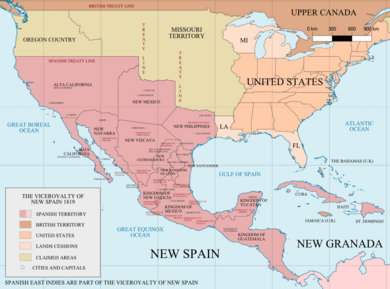
The United States was officially neutral in the Mexican War of Independence. But they allowed rebels to trade at American ports. Many rebel weapons came from the U.S. Americans also joined the fight. Natchitoches was a starting point for trips into Texas. In 1812, Mexican rebel Bernardo Gutiérrez de Lara led a small group of Americans into Texas. Indians from eastern Texas quickly joined. They called themselves the Republican Army of the North. They captured San Antonio in 1813. They killed Governor Manuel María de Salcedo. They declared Texas independent from Spain. The governor's death made many Anglo-Americans leave the cause. But on April 17, 1813, the Gutiérrez–Magee Expedition wrote Texas's first constitution. It created a strong central government. Spanish forces recaptured the province later that year at the Battle of Medina. They killed 1,300 people. They executed any Tejanos accused of supporting the rebels. Within two weeks, almost 400 rebels were executed. Their wives and daughters were imprisoned for two months. Royalist soldiers even chased women and children who fled San Antonio. Captured Americans could promise loyalty to Spain. Those who refused were sent back to the United States. Spanish general Arredondo feared the Comanche. He ordered all ranchers to move to San Antonio to help defend the city. When they returned to their ranches months later, the Comanche had killed all the animals. The Spanish army also looted the rest of Texas. By 1820, fewer than 2,000 Spanish citizens remained in Texas. "Spanish Texas, or what was left of it, was a desolate, unprotected land that could not feed itself."
Another revolutionary, José Manuel Herrera, created a government on Galveston Island in September 1816. He said it was part of a Mexican Republic. A group of French exiles from the U.S. tried to create their own colony. It was on the Trinity River, called Le Champ d'Asile. The exiles planned to use it to free New Spain and Napoleon. But they soon abandoned the colony and returned to Galveston.
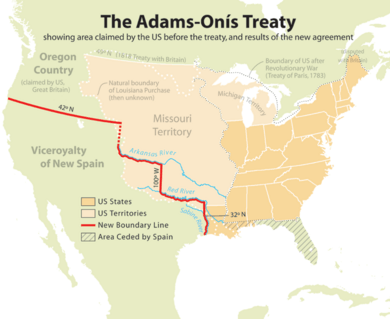
On February 22, 1819, Spain and the United States agreed on the Transcontinental Treaty. Spain gave Florida to the U.S. In return, the U.S. gave up its claim to Texas. The official border of Texas was set at the Sabine River. This is the current border between Texas and Louisiana. Then it followed the Red and Arkansas Rivers to the 42nd parallel (California's current northern border). For the next two years, Spain delayed approving the treaty. They used it to stop the U.S. from recognizing rebellious Spanish colonies as independent. During this time, many Americans spoke out against the treaty. They did not want to give up the claim to Texas. An essay in a newspaper said that a "league" of Texas land was worth more than all the land west of the Rocky Mountains.
In 1819, James Long led the Long Expedition to invade Texas. He declared Texas an independent republic. But by the end of the year, his rebellion was stopped. Colonel Juan Ignacio Pérez and his Spanish troops defeated him. The next year, Long set up a new base near Galveston Bay. He wanted to free Texas from "Spanish authority." But his reason for rebellion soon disappeared.
On February 24, 1821, Agustín de Iturbide started a movement for Mexican Independence. Texas became part of the newly independent nation without a fight.
Spanish Texas Population
| Year | Spanish/Criollo | % pop | Mestizo, Castizo and other castes | % pop | Amerindians | % pop | Slaves | % pop | Total Population | People per Square League |
|---|---|---|---|---|---|---|---|---|---|---|
| 1682 | 129 (Estimates for Ysleta Mission, first Spanish settlement in modern-day Texas) |
N/A | N/A | N/A | N/A | N/A | N/A | N/A | N/A | N/A |
| 1731 | 500 | N/A | N/A | N/A | N/A | N/A | N/A | N/A | N/A | N/A |
| 1742 (Peter Gerhard estimates) | 1,800 | N/A | N/A | N/A | 1,290 | N/A | N/A | N/A | 3,090 | N/A |
| 1761 | About 1,200 | N/A | N/A | N/A | N/A | N/A | N/A | N/A | N/A | N/A |
| 1777 | N/A | N/A | N/A | N/A | N/A | N/A | N/A | ~1% | 3,103 | N/A |
| 1780 | 2,000 | 50% | N/A | N/A | N/A | N/A | N/A | N/A | 4,000 | N/A |
| 1790 (Revillagigedo census) |
1,326 | 41% | 1,083 | 32% | 912 | 27% | N/A | 2.2% | 3,169 - 3,334 | N/A |
| 1800 | 4,800 (Juan Bautista Elguézabal census) |
N/A | N/A | N/A | N/A | N/A | N/A | N/A | N/A | N/A |
| 1810 | 5,000 | N/A | N/A | N/A | N/A | N/A | N/A | N/A | 3,334 (Fernando Navarro y Noriega estimate) |
N/A |
| 1821 | 2,500 | 10% | N/A | N/A | N/A | N/A | N/A | N/A | N/A | N/A |
| 1830 | 3,000 | N/A | N/A | N/A | N/A | N/A | N/A | N/A | N/A | N/A |
Spanish Legacy in Texas
After Spain, Mexico controlled Texas. So it can be hard to tell Spanish and Mexican influences apart. The most obvious legacy is the language. The state's name comes from a Spanish version of an Indian word. Almost every major river in modern Texas, except the Red River, has a Spanish name. 42 of the state's 254 counties and many towns also have Spanish names. Many words in American English, like barbecue, canyon, ranch, and plaza, come from Spanish. Another clear legacy is Roman Catholicism. When Spain ruled Texas, almost everyone was Catholic. Many people in Texas still practice Catholicism today. The Spanish missions in San Antonio, built to convert Indians, have been restored. They are now a National Historic Landmark.
Spanish policies changed the Texas landscape. As early as the 1690s, Spaniards brought European animals. These included cattle, horses, and mules. Some animals wandered off or were left behind when the Spanish left in 1693. Indian tribes then started managing herds of these animals. These herds ate a lot of native grasses. This allowed mesquite plants, which were native to the lower Texas coast, to spread inland. The new animals adapted well. But buffalo had trouble grazing among the new plants. This started the decline in their numbers. Spanish farmers also brought new ways of tilling and irrigating land. This further changed the landscape. Spanish building styles were also adopted in Texas. These include patios, tile floors and roofs, arched windows, carved wooden doors, and wrought iron designs.
Texas eventually adopted many Anglo-American laws. But many Spanish legal practices were kept. One was the Spanish idea of protecting some personal property from creditors. Texas was the first U.S. state to have a homestead exemption in 1839. Its property protection laws are now the most generous in the U.S. Also, Spanish law said that husbands and wives should share equally in marriage profits. Like many former Spanish provinces, Texas kept the idea of community property. It did not use the Anglo laws where all property belonged to the husband. Spanish law also allowed an independent executor in probate cases. This person does not need court permission for every action not listed in the will. Texas kept this idea. It has spread to other states, like Arizona, Washington, and Idaho. In other legal matters, Texas kept the Spanish principle of adoption. It became the first U.S. state to allow adoption.
See also
 In Spanish: Texas (Nueva España) para niños
In Spanish: Texas (Nueva España) para niños


